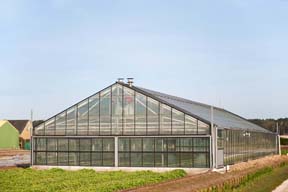Commercial Aquaponics’ Quick Start Guide – Dream Big
by Colle & Phyllis Davis
 If your dream is to enter into the exciting field of the commercial aquaponics business and you want to get started as soon as possible, here are some options for your consideration.
If your dream is to enter into the exciting field of the commercial aquaponics business and you want to get started as soon as possible, here are some options for your consideration.
- You will need greenhouse space and renting a greenhouse space (instead of buying land and building one yourself) is an affordable and easy way to get started. The biggest expense in starting up a commercial aquaponics installation is always the cost of the land and the greenhouses. By renting existing greenhouses, you can start in a matter of weeks. Plus, you may never build your greenhouses because renting space can give you a one-year ROI. That is extremely attractive. Contact a real estate broker in your area to inquire about the rental availability of greenhouses in your area.
“The agricultural sector is going to face enormous challenges in order to feed the 9.6 billion people that the FAO predicts are going to inhabit the planet by 2050: food production must increase by 70% by 2050, and this has to be achieved in spite of the limited availability of arable lands, the increasing need for fresh water (agriculture consumes 70 per cent of the world’s fresh water supply) and other less predictable factors, such as the impact of climate change, which, according a recent report by the UN could lead, among other things, to changes to seasonal events in the life cycle of plant and animals.” – The Future of Agriculture- Smart Farming by Federico Guerrini, Forbes Magazine.
If you rent or build your own greenhouse, here are some necessities for a successful aquaponics greenhouse structure:
- Orientation: Mostly North/South for the long axis in Northern Hemisphere. There are many exceptions/
- Ideal temperatures: Interior 60° to 100° (15 to 38C) for plants and 70° to 90° (21 to 32C) for fish.
- Sunlight: Minimum 6 hours of DIRECT sunlight or equivalent per day
- Ventilation: Interior air movement and venting to the outside to control humidity and temperature
- Water: Potable water available inside structure always
- Electrical power: Needed to run pumps and other electrical equipment including fans, heaters, and lights. Can be solar or other alternative energy source.
 2) Here is the most important question to ask yourself before you launch your commercial aquaponics farm, ‘Who is your market?’ In our eBook Commercial Aquaponics GOLD the number task to do before you do anything else is to define your market. What will you grow? Who will buy your production? A commercial aquaponics installation produces a scary amount of produce and keeps doing it every week for as long as you want.
2) Here is the most important question to ask yourself before you launch your commercial aquaponics farm, ‘Who is your market?’ In our eBook Commercial Aquaponics GOLD the number task to do before you do anything else is to define your market. What will you grow? Who will buy your production? A commercial aquaponics installation produces a scary amount of produce and keeps doing it every week for as long as you want.
Here is a weekly updated report from the FDA entitled National Retail Report for Specialty Crops. It lists the retail prices for the most popular fruits and vegetables in the United States each week. For example:
December 3, 2021. Red Leaf Lettuce – Selling in US – $1.30 per weighted average price – sold in 1,030 stores.
December 3, 2021. Red Leaf Lettuce – Selling in US – $2.90 per pound –
sold in 93 stores.
As you plan your crops, you must compete with either price or freshness, quality, and availability.
PLEASE NOTE: Aquaponics grows ‘above ground table vegetables’ like lettuces, basil, Swiss chard, kale, bok choy, mustard greens and some blooming plants such as green beans. It does not grow root vegetables (potatoes, carrots, etc.), and does not grow fruits that are grown on trees (apples, pears, or plums), or on larges bushes that prefer dry sandy soil (melons or berries).
Your best markets are casinos, high-end restaurants, resort hotels, and specialty markets. You will take years longer to make your money back if you go the wholesale route, no matter how much you sell. Sell to the chefs and buyers who must please the most discerning customers, and they will pay the best prices.
 3) To become a successful commercial aquaponics systems business owner. First, what size space do you need. After interviewing, in person, at least ten chefs add up the number of boxes of lettuce, basil, tomatoes, and whatever else they want to buy from you and divide the number by half. This process gives you a build-in expansion to satisfy their demand.
3) To become a successful commercial aquaponics systems business owner. First, what size space do you need. After interviewing, in person, at least ten chefs add up the number of boxes of lettuce, basil, tomatoes, and whatever else they want to buy from you and divide the number by half. This process gives you a build-in expansion to satisfy their demand.
Fun story: The first time you deliver a box or two of lettuce and the chef tastes it, they may cry. It will be the best lettuce they have had in years. Then in a few weeks, they will ask you if you can provide different lettuce, say red leaf or butter, and here is where you own them. The ‘special orders’ are where you make the most money, grown to order, local, pesticide-free are super sexy, and the product is the finest available.
 4) How much can you grow in the space you are renting? With the market requirement in hand, the formula for maximizing the floor space in a greenhouse is to divide the total floor space by 350. Example a greenhouse 30 x 90 = 2700 sq ft. Divide by 350 (sq ft for each Module) to get 7.7 modules. Depending on the physical layout, a maximum of 7 Portable Farms Modules will fit in that space. Using the Commercial Aquaponics GOLD eBook means you will be selling to upscale markets you would make back your initial investment in one growing season!
4) How much can you grow in the space you are renting? With the market requirement in hand, the formula for maximizing the floor space in a greenhouse is to divide the total floor space by 350. Example a greenhouse 30 x 90 = 2700 sq ft. Divide by 350 (sq ft for each Module) to get 7.7 modules. Depending on the physical layout, a maximum of 7 Portable Farms Modules will fit in that space. Using the Commercial Aquaponics GOLD eBook means you will be selling to upscale markets you would make back your initial investment in one growing season!
Remember, you are only using enough space to satisfy one-half of the demand. Therefore, you need to get your hands wet, your crew trained, your delivery system worked out, and have shipped products before committing to a larger space.
Today is the first day of your new project. Get started by buying the Commercial Aquaponics GOLD interviewing chefs, looking for greenhouse space, and taking the Aquaponics University Portable Farms Aquaponics Systems Course©.
- Sample Greenhouse Facility Lease
https://www.canr.msu.edu/resources/sample_greenhouse_facility_lease_e3141
- How to Start a Plant Nursery from Home
https://www.gardenguides.com/123065-start-plant-nursery-home.html
- Leasing greenhouse space
https://www.greenhousemag.com/article/gmpro_0110_technology_greenhouse_space/
3 comments
Greetings!
Hello!
Our nonprofit organization is initiating a project in the Philippines to provide food security and livelihood for a small village in Kuyaoyao, Quezon Province. We are interested in your company’s agency to guide implementing the scope of commercial aquaponics in its entirety to a business model for local and global reach. Our end goal is to provide the village the knowledge and equipment for self-sustainability.
This project is a pilot program, and with your assistance, can be the start of an expansion to other impoverished countries. We look forward to your reply, and the commencement of an endeavor shared for the greater good.
Respectfully,
Al Galarpe
Author
Mr. Galarpe: Thank you for your inquiry about Portable Farms Aquaponics Systems for your project in the Phillippines. We also appreciate your purchase of our book Commercial Aquaponics GOLD. Colle Davis, CEO, PFAS LLC, is responding to you by email.
Phyllis Davis
President, PFAS LLC
Author
Al:
We are having a sale- August 2 – 6, 2021. Visit the link to learn more: https://portablefarms.com/2021/portable-farms-sale-august-2-6-2021
Our NEWLY REVISED 2021 ONLINE self-paced aquaponics course contains all we’ve learned in our 49 years in the field of aquaponics and includes a Portable Farms® Kit containing the technology that is the ‘heartbeat of the system’ that allows our systems to grow such beautiful food and healthy fish.
In celebration of Portable Farms® 13th Year Anniversary, we’re offering
the sale of One Portable Farms® Course and Kit for $1,399.00.
Buy one Portable Farms® Course and the Kit – $1,399.00
or Buy Two Portable Farms® Courses and Kits – $1,999.00
O’fish-ally Your Friends,
Phyllis and Colle Davis